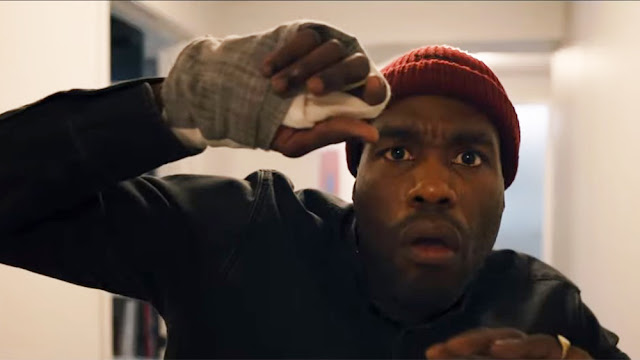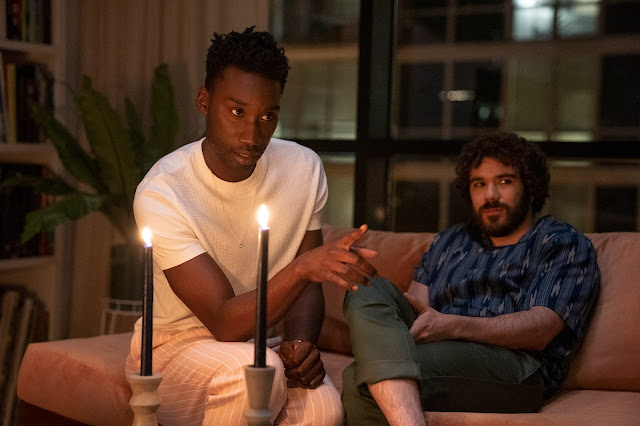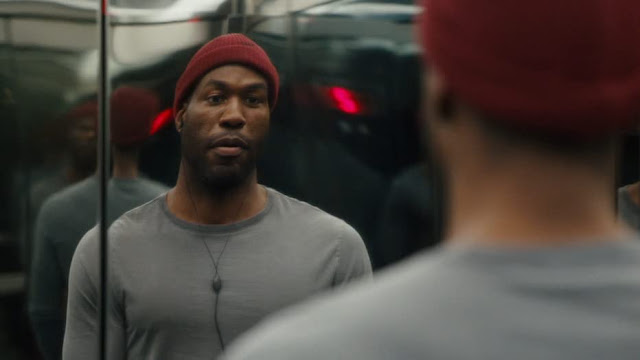- Get link
- X
- Other Apps
- Get link
- X
- Other Apps
 |
| Yahya Abdul-Mateen II as ANTHONY in CANDYMAN (2021) |
Stories alter widely depending on who takes the driver's seat. The storyteller determines who comes out looking like a hero or villain and who doesn't get remembered at all. Nia DaCosta plays with this reality in her new version of Candyman, directly commenting upon the narrative put forth in the original film, directed by Bernard Rose. The versioning and reversioning of the history of Cabrini-Green and Candyman stands out as the strongest part of the film. Unfortunately, although the new Candyman improves upon its predecessor in production value, visual effect, and authentic portrayal of the Black community it seeks to honor, ultimately the film settles for being better rather than great.
The Candyman of the 90s tells the story of Helen Lyle, a white graduate student who follows the urban legends circulating about Candyman, a Black man with a hook for a hand that slices those who say his name five times from groin to gullet. She tracks the stories to the Cabrini-Green housing project in Chicago, trying to discover the truth about the man behind the myth. When the film first released, it captivated attention for depicting the everyday hardships of a Black community. And who can forget the iconic appearance and voice of Tony Todd, the OG Candyman? However, a recent rewatch made for a cringeworthy experience indeed as it was clear whose story was being told.
That 1992 Candyman portrays Helen as the hero. Helen shows up at Cabrini-Green against the advice of her Black friend and fellow researcher, Bernadette (Kasi Lemmons). The two of them walk the halls taking photographs of the graffiti. "I'm not a cop," becomes Helen's anthem and excuse as to why residents like Anne-Marie McCoy (Vanessa Williams) and young Jake (DeJuan Guy) should open up to her and trust her. Anne-Marie calls it from the get-go: "White people never come around here except to cause us a problem." Helen assures her that she's not here to cause trouble, but that's exactly what happens. Helen isn't there to help. She wants to use the residents to gain attention for her research. She manipulates Jake into showing her where Candyman lives and vow to keep it a secret. But push comes to shove, Helen can't keep these promises. And any doubts as to who is situated as the hero gets erased when the whole community of Cabrini-Green shows up graveside to honor Helen.
 |
| [L-R] Nathan Stewart-Jarrett as TROY, Kyle Kaminsky as GRADY in CANDYMAN (2021) |
In the 2021 Candyman, DaCosta places the Black lens firmly in the driver's seat. No longer do we follow the story from the white gaze. This alters not only the story being told but how Helen Lyle is remembered. Anthony McCoy (Yahya Abdul-Mateen II; The Trial of the Chicago 7) needs new inspiration for his art. At a dinner that he and his girlfriend, Brianna (Teyonah Parris; WandaVision) throw for her brother Troy (Nathan Stewart-Jarrett) and his new boyfriend (Kyle Kaminsky), Troy tells the story of Helen. Only the details change. In Troy's version, Helen kidnaps the baby and tries to kill it, which is a far cry from the events depicted in the 1992 film. Proponents of the OG Candyman film may chaffe at this altered story, but an important point about history is made at this moment: History belongs to the teller. Throughout the movie, the viewer's understanding about Candyman continues to evolve based on the storyteller and their experience.
Anthony feels connected to the story and convinced that his next artistic inspiration lies in the grounds of Cabrini-Green. Just like Helen, he seeks the truth through the stories and memories of those who remember Helen, Candyman, and their legacies. But some memories are better forgotten. As Anthony follows the clues, his physical, mental, and emotional suffering begins to mirror events of the past.
The new Candyman features an outstanding production design overall. The visual look impresses with well-crafted camera work. Cinematographer John Guleserian makes good use of mirrors when jacking up the creep factor. There is a masterful alteration between over the shoulder and head-on shots that has the viewer always unsure of what's coming from any one direction. Gasp-worthy visual effects reign supreme in this film, with gruesome kill counts and an oozing skin rash that ravages Anthony's body. Composer Robert Aiki Aubrey Lowe used ambient sounds recorded at Cabrini-Green to create a soundscape for the film. Anyone would be hard pressed to follow in the footsteps of Philip Glass, who created the score for the OG Candyman, but to Lowe's credit, his choices do follow some of the appeals of Glass' work, with repeating segments, nontraditional time patterns, and layered sounds.
So the visuals, music, and gruesome kills stay up to par. The problem remains that the story lacks focus and a clear narrative. The story jams in multiple types of horror, which all function to provoke different responses. This leaves the viewer reeling from whiplash. Slasher horror and body horror elicit visceral reactions, social horror brings out thoughtful responses, while psychological horror triggers the emotions. Candyman throws all of these subgenres into the crockpot, creating a mixture that is ineffectual. Sticking to one of these types would have made for a stronger film overall. Prioritizing social horror would have made sense based on DaCosta's partnership with Jordan Peele. But when the film switches to slice-em-up slasher horror, it takes focus off the deeper message.
Another issue arises with the pacing. Candyman starts with a leisurely pace, taking its time to establish the story and the mood before growing in intensity. The intensifying pace can be a fine choice if it's done in a steady way, like a crescendo. Candyman stays in slow gear for most of the film and then kicks it into overdrive, squeezing all of the intensity into a final 15 minutes. Odd story tangents even stall the process, such as when the narrative shifts from Anthony's perspective to that of his girlfriend, Brianna. Brianna begins to remember things from her past triggered by Anthony's obsession. But this is done clunkily, and the purpose of these shifts never becomes clear. DaCosta no doubt wanted to make a case that the trauma of Candyman extends far beyond one person. If that's the case, the screenplay never does the work needed to make that connection clear.
The new Candyman leans hard into the social commentary at the expense of story. The escalating last chapter did have me at the edge of my seat, but the ending felt odd and fell flat. What did DaCosta want viewers to take away from this film? The racial and generational trauma felt by communities of color is boundless; this we know. I'm glad the 2021 Candyman situates Black voices as the stars of the story. But I'm not sure what else was accomplished. Horror rarely ends on a note of hope, but usually, at least for now, the nightmare has been laid to rest. In Candyman, there's no close. And in an issue-driven social horror, that seems cruel.
Release info: In theaters August 27, 2021
Final score: 3.5 out of 5
Another issue arises with the pacing. Candyman starts with a leisurely pace, taking its time to establish the story and the mood before growing in intensity. The intensifying pace can be a fine choice if it's done in a steady way, like a crescendo. Candyman stays in slow gear for most of the film and then kicks it into overdrive, squeezing all of the intensity into a final 15 minutes. Odd story tangents even stall the process, such as when the narrative shifts from Anthony's perspective to that of his girlfriend, Brianna. Brianna begins to remember things from her past triggered by Anthony's obsession. But this is done clunkily, and the purpose of these shifts never becomes clear. DaCosta no doubt wanted to make a case that the trauma of Candyman extends far beyond one person. If that's the case, the screenplay never does the work needed to make that connection clear.
The new Candyman leans hard into the social commentary at the expense of story. The escalating last chapter did have me at the edge of my seat, but the ending felt odd and fell flat. What did DaCosta want viewers to take away from this film? The racial and generational trauma felt by communities of color is boundless; this we know. I'm glad the 2021 Candyman situates Black voices as the stars of the story. But I'm not sure what else was accomplished. Horror rarely ends on a note of hope, but usually, at least for now, the nightmare has been laid to rest. In Candyman, there's no close. And in an issue-driven social horror, that seems cruel.
Release info: In theaters August 27, 2021
Final score: 3.5 out of 5


Comments